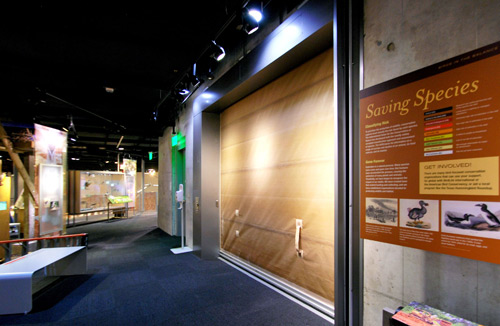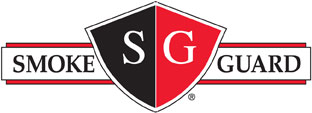Fire and Smoke Curtains: Meeting Atrium Code Requirements
INTERIOR STAIRS AND ESCALATORS
According to IBC Section 708.2, escalator openings or stairways that are not a portion of the means of egress can be protected without requiring a smoke exhaust system as would be required for an atrium.
There are exceptions however. Exception 1 states that for openings that do not exceed four stories and where the opening size does not exceed twice the horizontal protected area of the stair/escalator, a draft curtain and closely spaced sprinklers are required.
 |
Typical example of a smoke- and draft-compliant curtain assembly is deployed upon a signal from the local smoke detection system. Occupants can press two wall switches mounted on opposing walls to enable egress, after which the curtain will re-deploy if the system is still in alarm. Photo courtesy of Smoke Guard, Inc. |
Exception 2 states that for larger openings or stair/escalator openings exceeding four stories, the opening may be protected by approved power-operated automatic shutters at every penetrated floor, having a fire resistance rating of not less than 1.5 hours. It should be noted that this exception does not specify whether the automatic shutters should be arranged vertically at the perimeter of the opening or horizontally across the opening at the floor.
Roll down smoke and draft curtain for stairs and escalator openings meet code requirements for openings less than four stories. One typical model for polygon and rectangular enclosures is available in dimensions up to 52 ft 5-3/4-in. per side with a maximum perimeter length of 164 ft. Escalators are often fitted with controls that permit them to continue one more cycle before the last curtain comes down.
SUSTAINABILITY FACTORS
Flexible fire and smoke curtain assemblies support sustainable design in several ways. They provide the means to deliver larger daylight-filled code-compliant structures and, by occupying less valuable square footage, increase usable productive areas. They are constructed of sustainable materials, reduce energy consumption and lessen the assumed need for code-required structural and mechanical materials. Fire and smoke curtains make a great deal of sustainable sense.
 |
Constructed of stainless steel strengthened glass filament fabric with polyurethane and black identification stripes, this curtain is approximately 0.02 in. thick and is fire-rated up to 2 hours. Photo courtesy of Smoke Guard, Inc. |
They are also healthier. "They are ideal for the healthcare environment," says project manager Terry Russell, AIA, LEED AP, CSI, CDI, HDR Architects. "Since they are completely hidden until fully deployed, there are no hidden areas to promote hidden growth of bacteria."
Leadership in Energy and Environmental Design (LEED®)
Following are categories where flexible fire-rated and smoke curtains could contribute LEED points under New Construction and Major Renovations:
MR Credit 4: Recycled Content 1–2 Points
Intent: to increase demand for building products that incorporate recycled content materials, thereby reducing impacts resulting from extraction and processing of virgin materials.
One provider of smoke and fire curtains has calculated that the average curtain system is comprised of as much as 30 percent of recycled materials based on the sum of post-consumer recycled content plus half of the pre-consumer content. The post -consumer portion is approximately 20 percent. The pre-consumer portion is approximately 10 percent. (Note: Some systems currently offered are awaiting recycled content calculations.)
IEQ Credit 8.1: Daylight and Views—Daylight 1 Point
Intent: To provide building occupants with a connection between indoor spaces and the outdoors through the introduction of daylight and views into the regularly occupied areas of the building.
IEQ Credit 8.2: Daylight and Views—Views 1 Point
Intent: To provide building occupants a connection to the outdoors through the introduction of daylight and views into the regularly occupied areas of the building.
An atrium supports the use of daylighting strategies, which have been demonstrated to reduce operating costs and deliver energy savings through improved life cycle costs and reduced emissions.
Many architects say they are frustrated by complex and expensive smoke control requirements when they try to incorporate atrium designs into projects. Providing a simpler and less expensive smoke control solution that supports atrium designs would allow them to consider this design option for more projects.
Materials & Resources (MR) Credit 5: Regional Materials
Intent: To increase demand for building materials and products that are extracted and manufactured within the region (500-mile radius.)
Design professionals should check with manufacturers to ascertain if particular smoke and fire curtains qualify for this credit.
ID Credit 1 Innovation in Design 1–5 Points
Intent: To provide design teams and projects the opportunity to achieve exceptional performance above the requirements set by the LEED Green Building Rating System.
Smoke and fire curtains support more innovative design by allowing simpler, more economical code compliance solutions for atrium designs, large unenclosed spaces and all building areas.
Smoke and fire curtains allow elimination of enclosed occupant and service areas and equipment-dedicated space. Square footage can then be reallocated, thus increasing the economic value of the project.
Specifying simpler smoke and fire curtains also can result in significant reduction in construction materials and mechanical equipment.
CONCLUSION
Relatively new to the United States, but well-tested in Europe, fire- and smoke-rated curtains are clearly an effective answer to meeting life safety requirements of atrium designs and the open spaces surrounding interior stairs and escalators. They are less complex and less expensive than comparable smoke exhaust mechanical systems, and are the simplest system to certify or commission. They also require less energy to operate during mandatory testing and the curtain assemblies themselves are constructed from recycled materials. For atrium designs with three floors or more, architects now have the choice of having a cost-saving, simpler and more environmentally conscious smoke exhaust system by supplementing it with fire and smoke curtains.
With their economic and performance benefits, curtain systems facilitate the inclusion of atrium designs in more projects—particularly for projects which would have rejected the inclusion of an atrium because of high code compliance costs. They thus add to a building's sustainability goals by contributing to the design of more daylighting options—which have long been proven to reduce energy costs and enhance occupants' health, wellbeing and productivity. Fire and smoke curtains clearly present cost-effective and sustainable solutions that should prove very valuable.
 |
| Flexible fire and smoke protection systems are the focus at Smoke Guard – and have been for more than a decade. We specialize in reclaiming usable space and providing code-compliant fire and smoke curtain solutions to protect openings throughout your entire building. In many situations, such as atriums, our flexible curtain systems can replace the need for large smoke control systems and costly additional construction. www.smokeguard.com |








